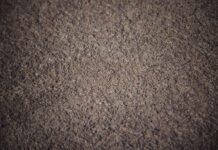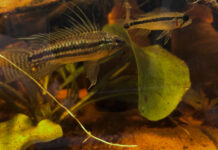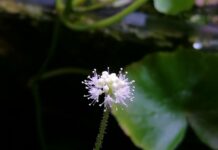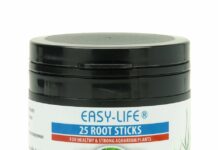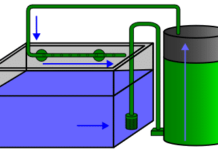In this article we will take a look at Hydrocotyle leucocephala.
This is a fairly common aquarium plant which is easy to find, but that can have very interesting characteristics, such as a wide adaptability to various aquarium conditions and the possibility of growing above ground.
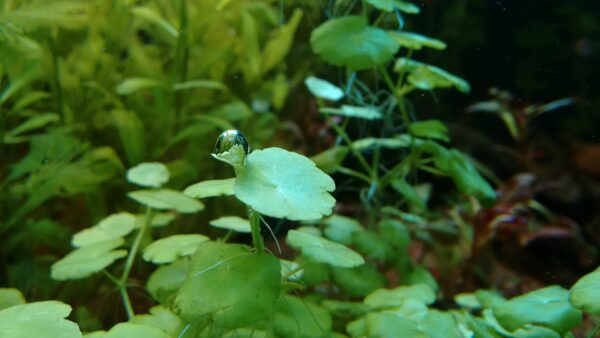
Description of Hydrocotyle leucocephala
Hydrocotyle leucocephala is a plant of the Apiaceae family, the same family as carrots, caraway, parsnips and parsley.
Incidentally, if you try to chop up some Hydrocotyle leaves, the smell will be very pleasant and similar to that of parsley – but don’t use it in cooking!
The etymology of the name comes from hydor (water), kotyle (navel) and leuco-cephala (white head, referring to the inflorescence).
The English common name, on the other hand, is “Brazilian pennywort“.
From its English name, we can guess that it is a South American plant: in fact it is widespread from the south of Mexico to the north of Argentina.
Hydrocotyle is an amphibious, crawling plant that can live submerged, floating and partly emerged, in conditions of high humidity.
Thin, light green, rounded roots and leaves with diameters of up to 5-8 cm grow from each node.
In particular conditions, it can produce inflorescences on a peduncle about ten centimetres long.
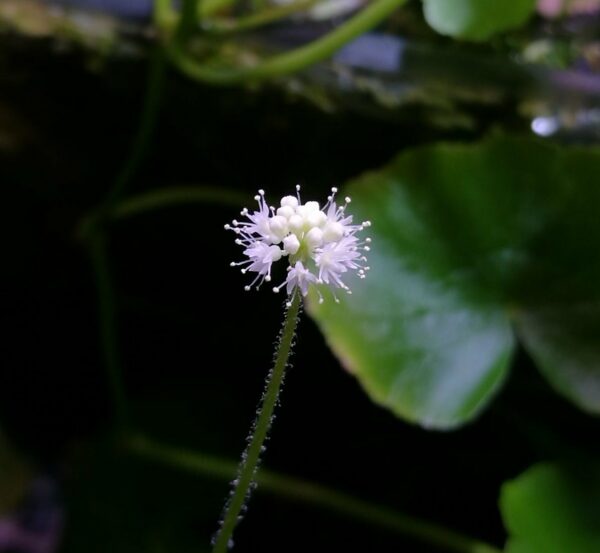
Cultivation of Hydrocotyle leucocephala
Hydrocotyle leucocephala is very easy to find; practically every aquarium shop has at least a few specimens.
It is also possible to obtain new plants from the prunings of other enthusiasts: a small branch is enough to get you started.
In both cases, you are almost always starting with a submerged culture, so the plant will not have too many difficulties acclimatising.
Fertilisation
H. leucocephala is not fussy about nutrients.
Obviously it cannot grow without nutrients, but it will adapt its growth speed and leaf size according to the presence of nutrients.
In particular, if a lot of macro nutrients are present (especially nitrogen such as nitrate), it can take up a lot, especially if it is close to the surface or with emerged leaves.
I would also point out that the plant can be a very good indicator of magnesium deficiency: if the old leaves of the plant start to turn brown at the edges, it is highly likely that this element is missing.
It is also good to know that the plant, being very fast, can make other, slower plants deficient in nutrients (especially the aforementioned magnesium).
Carbon dioxide (CO2) is not essential for its growth, especially if there are emerged leaves. However, a good presence of carbon can improve the growth of the submerged parts.
Finally, contrary to most other plants, the roots that Hydrocotyle emits from each node are not a sign of nutrient deficiency: they are always present.
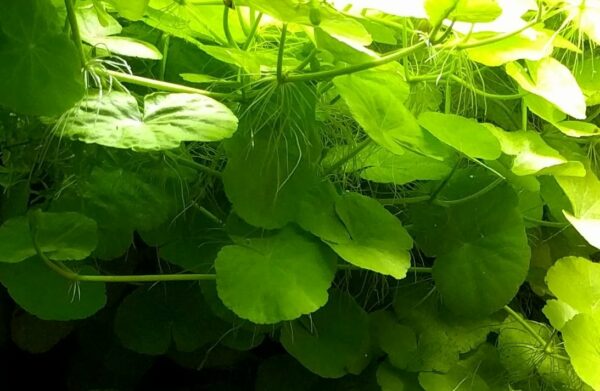
The emerged part, if present, has no roots on the nodes.
Growth and propagation
Hydrocotyle leucocephala always tends to grow upwards, to reach the surface and grow floating, with emerged leaves, getting the maximum benefit in terms of exposure to light and carbon dioxide.
This can be prevented by cutting back any branches that tend to stick out of the water, forcing the plant to grow submerged.
However, if you have an open aquarium, Hydrocotyle can, in my opinion, make the most of its beauty with its emerged part.
To bring the plant to the surface, I have observed that pulling a branch of the plant out of the water rarely works.
Instead, I recommend waiting for the plant itself to decide to emerge.
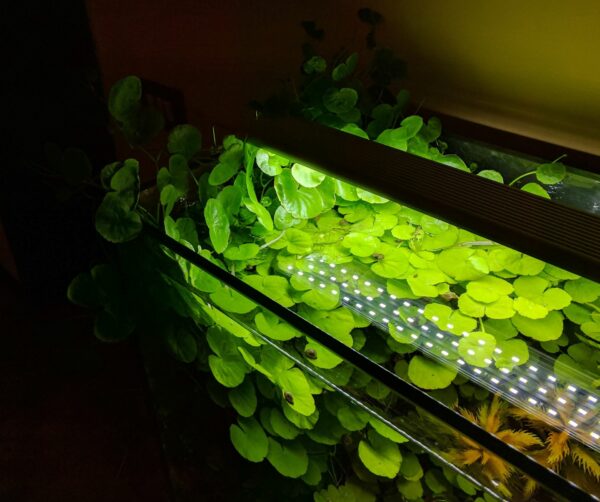
If it does, the success of the emerged part is almost guaranteed (the only pitfalls are a too dry environment or proximity to lamps, which can burn the leaves with the heat produced).
Once emerged, the branches tend to lose their submerged leaves, as they become almost useless, being shaded by the emerged leaves and the latter having a much greater advantage in terms of light and carbon.
To avoid this, I recommend keeping some branches submerged by cutting them off before they emerge from the water. By doing this, these branches with leaves will hide the leafless branches that have emerged.
As far as propagation is concerned, nothing could be easier. Simply cut off a small branch, preferably submerged, keeping at least 3-4 nodes and you will have a new plant.
Location
Because of the way it grows, the ideal position is on the rear or on the sides of the tank.
In particular, if you have an open aquarium, with the lateral position it is easy to obtain a good development of the emerged part, as you can see in the photos above.
I would not recommend frontal positioning, as H. leucocephala will block the view of the aquarium, unless you grow it as a lawn (in which case you will need excellent light output, CO2 and fertilisation).
For a lawn or frontal position, I would recommend the species Hydrocotyle tripartita, which has a more horizontal growth than H. leucocephala.
Conclusion
This is an extremely common plant, but if kept well (in an open aquarium, partly emerged!) it can give great satisfaction for very little expense.
It helps a lot with the absorption of waste substances and it is an excellent indicator for the deficiency of the nutrient magnesium (for which there are tests, but they are uncommon and relatively expensive).
It is also suitable for newbies, as long as even basic fertilisation is provided. As you become more familiar with the fertilisation and the plant, you can make it grow better and better.
Bibliography
Aquarium Plants, Christel Kasselmann, Krieger Publishing Company, Malabar, Florida, 2003.

